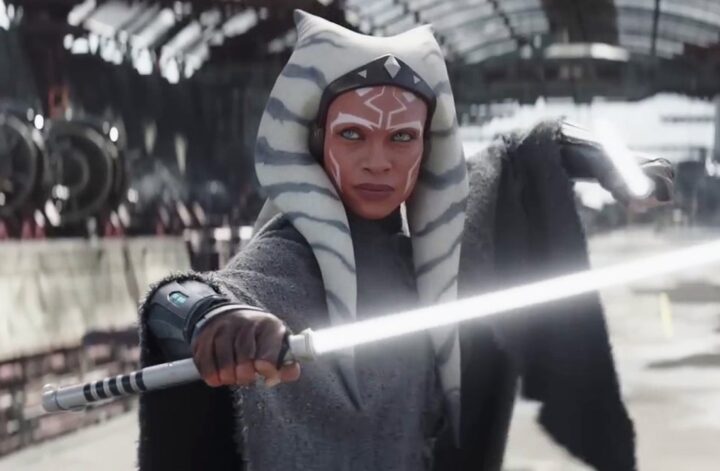This is a spoiler-free review of Star Wars: Ahsoka, which premieres August 22 at 9 p.m. ET, but be aware: The following contains major spoilers for Star Wars Rebels.
For better and worse, Ahsoka is effectively a live action sequel to Dave Filoni’s Emmy-nominated animated series Star Wars Rebels. As a huge fan of that show, it’s exciting to see the characters and world get a second life and the chance to continue the story left open-ended by Rebels’ excellent finale. Unfortunately, the need to catch new viewers up on the adventures of the Ghost and what its crew have been doing since the Galactic Empire fell leaves the first two episodes of Ahsoka feeling a bit slow.
Part of the problem is that the characters felt more lively when they were animated. Filoni writes and directs the emotionally muted series premiere where Ahsoka Tano (Rosario Dawson), Jedi apprentice to Anakin Skywalker turned Rebel leader, reunites with her former allies – ace pilot and general Hera Syndulla (Mary Elizabeth Winstead) and Mandalorian artist and demolitions expert Sabine Wren (Natasha Liu Bordizzo). Dawson brings a flat zenness to the character originally voiced with far more zeal and ferocity by Ashley Eckstein. That worked fine in her appearances in The Mandalorian and The Book of Boba Fett, when she was a mysterious ally to Din Djarin (Pedro Pascal) emblematic of the Jedi way. But it makes it harder to connect to her as a protagonist. That’s exacerbated by a stiffness in the delivery of both Winstead and Bordizzo as they cryptically hint at past events without digging into what happened to drive Sabine and Ahsoka apart. Even David Tennant, reprising his role as the Jedi instructor droid Huyang from Filoni’s Star Wars: The Clone Wars, doesn’t offer much beyond a bit of pedantic nagging.
The best performance of the first two episodes belongs to Clancy Brown, who reprises the role of Ryder Azadi, the Imperial politician-turned-resistance leader he played on Rebels. Brown provides a sense of continuity in his deep gratitude for and exasperation with Sabine, a reluctant hero who feels that her victory was incomplete and is uncertain about what her role should be in the New Republic.
While the performances by the new actors are underwhelming, the visuals are absolutely spectacular. The highways and spires of Lothal – the planet at the heart of Rebels – have been meticulously recreated in their shining glory, as has the mural depicting the heroes that first appeared in the series finale. The animatronic Loth-cats look impressively lifelike and adorable, whether popping up their oversized heads in a field or purring in Sabine’s home. The details of a stellar map unlocked in episode 2 and featured in its end credits are gorgeously rendered, unveiled with drama amplified by the show’s excellent music and sound design.
Ahsoka’s fight scenes are strong, seamlessly blending ground and aerial combat. Highlights include Ahsoka cleverly dispatching a group of droids by taking the ground out from under them with a whirl of her two lightsabers before narrowly fleeing a massive explosion, and Ahsoka engaged in a lightsaber duel while Hera chases down a transport ship with the help of her manic droid Chopper (Filoni, in yet another Rebels encore).
Rebels ended with space whales dragging the Imperial mastermind Grand Admiral Thrawn (Lars Mikkelsen) into an unknown section of the galaxy along with the young Jedi Ezra Bridger (Eman Esfandi, inheriting the role from Taylor Gray). Filoni has always loved digging into the stranger corners of Star Wars lore, and Ahsoka promises more of the same with its focus on ancient civilizations and the Witches of Dathomir, a group prominently featured in The Clone Wars. That certainly has the potential to distinguish Ahsoka from the other live action Star Wars shows, leaning into the mystical and philosophical foundations of the franchise by delving into unexplored areas of the galaxy rather than continuing to focus on Coruscant and Tatooine.
Particularly intriguing is the show’s examination of what it means to be a Jedi. Ahsoka received all of her training while the order was actively at war, watched it fall, and now seeks to embody its code as a wandering hero with an apprentice who can’t even use the Force. Building on this theme is Baylan Skoll (the late, great Ray Stevenson), a Jedi turned mercenary who may wield a red lightsaber and be employed by an Imperial, but feels a nostalgic connection to his former order.
Ahsoka is better when focusing on the cosmic rather than the practical. A detour to uncover corruption at a Republic shipyard builds on a concept introduced in The Mandalorian episode “The Convert”: Many see the difference between the Galactic Empire and the New Republic as purely political. The plot ends with a trite explanation by Ahsoka that the perpetrators were driven by greed and not any sense of loyalty to the Empire, something that doesn’t really match with their actions and feels particularly simplistic compared to the nuanced portrayal of those who serve the Empire in Andor.
